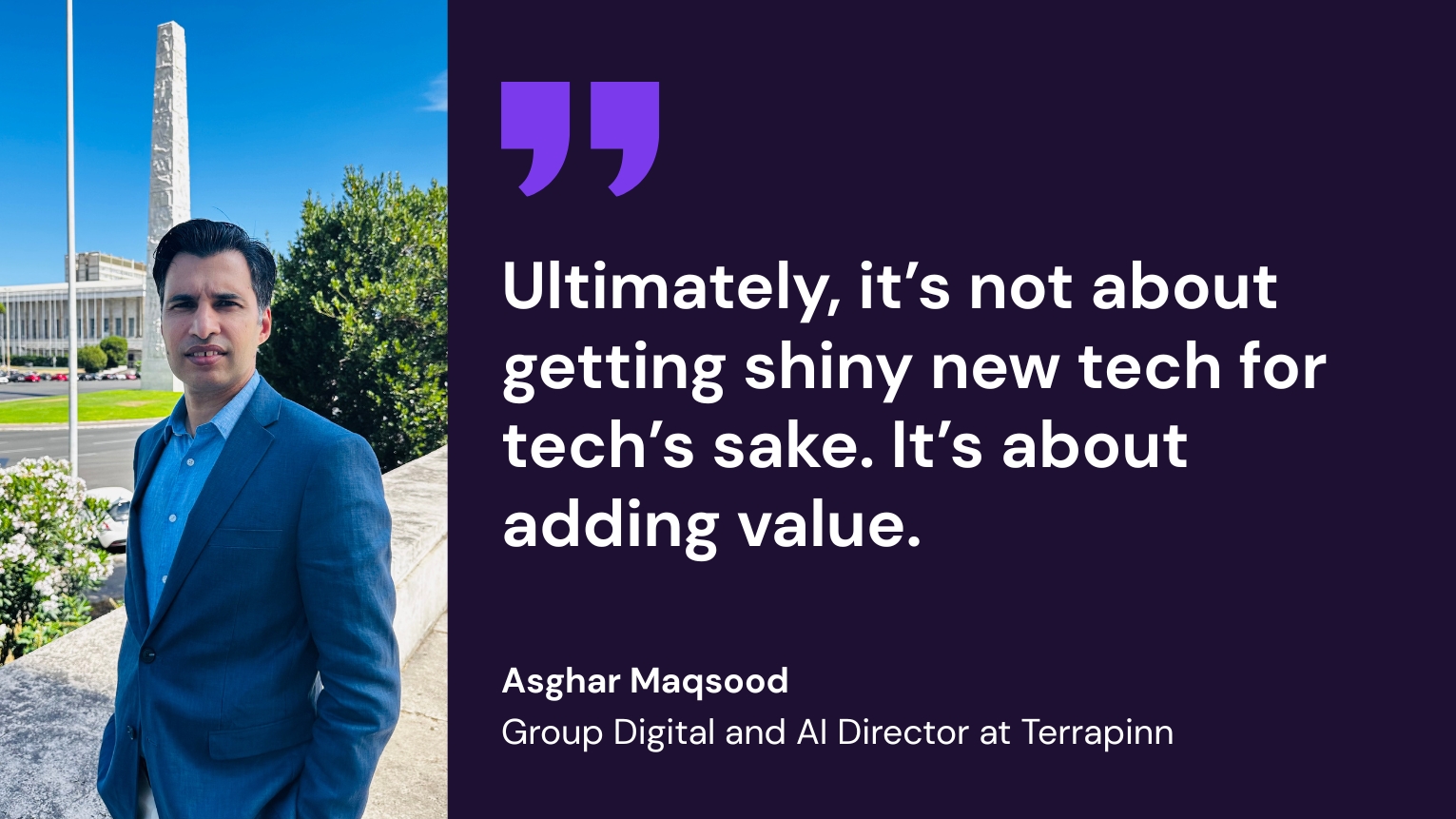The Right AI Perspective
As the digital and AI landscape evolves, many organizations find themselves trapped in a cycle of endless AI experiments, with countless pilots that never move beyond the testing phase. Terrapinn, a global events and media company, has a different story. Under the leadership of Asghar Maqsood, Group Digital and AI Director, Terrapinn is moving from AI-powered pilots to scalable, impactful solutions that drive tangible business results. The truth is, the goal isn’t to embed AI everywhere; it’s to solve business problems and create measurable impact.
We recently sat down with Maqsood to discuss the strategy behind his success in scaling AI in events. His insights reveal that true AI transformation isn’t about the technology itself; it’s about a strategic, human-centric approach.

The Terrapinn Blueprint: From “Why” to “What”
For Maqsood and his team, every successful AI initiative begins with a single question: “What are our pain points?” This value-first mindset ensures that AI is never seen as a shiny new tool, but as a strategic asset designed to solve real business challenges. This approach is built on three core principles:

1. Start with value
Instead of chasing tech for tech’s sake, Terrapinn first mapped out the biggest challenges across its operations, from attendee experiences to sales processes to marketing campaigns. A question is always asked, “Where can AI add value back to our event?”
That mindset meant AI wasn’t framed as a cost-saving trick or a vague innovation project. It was a business strategy. Every trial had to answer: did it make the event easier to attend, the sponsor story sharper, or the sales cycle faster?
2. Prove it, then scale it
Every AI initiative begins with a clear hypothesis tied to a business problem.
Test your hypothesis very quickly, don’t sit on it forever. If the hypothesis is validated, scale it. If it’s not validated or it’s not scalable, move on.
And scalability matters. If a solution can’t be rolled out across Terrapinn’s global portfolio, they don’t pursue it.
We want to make sure any AI solution we bring in is scalable very quickly across all events, because that’s where we start seeing the biggest return on investment.
3. Keep humans in the loop
Terrapinn never positioned AI as a replacement for people. Instead, they involved teams early and made them part of the journey. That turned fear of replacement into advocacy for adoption.
We want AI to amplify what we are doing. We are not looking to replace people, we are looking to leverage AI to produce better results. AI is here to augment our colleagues rather than replacing them.
Turning Principles Into Practice
These principles came to life with one of Terrapinn’s biggest operational challenges: the high volume of repetitive attendee questions. Running 90+ events meant teams were drowning in repetitive queries, from “Where’s my badge?” to “What time does the keynote start?”
The hypothesis was simple: if an AI concierge could handle routine questions, teams could focus on higher-value work while attendees got instant answers. Terrapinn partnered with Bridged to launch event-specific Knowledge Agents across their websites.
The pilot showed the technology worked, but more importantly, it proved the teams could own it. Staff were responsible for training the agents, shaping tone, and feeding in the right information. Because they were involved from day one, they saw the value first-hand and became champions for scaling.
From there, momentum accelerated. Once the initial agents delivered results, the same model was rolled out to more than 50 events.
They’ve been a game changer. Always on, answering questions 24/7 for attendees and sponsors. They make the experience better, people don’t need to wait for somebody to come online or scroll through a Q&A. They get answers instantly.
One thing is clear: Terrapinn didn’t escape the pilot phase by luck. They stuck to their three principles: start with value, prove it before scaling, and keep people in control.
Practical Advice for Scaling AI in Events
For companies stuck in endless experimentation, Asghar’s message is direct:
If AI is treated as a side project, it will never get out of the experimentation phase.
His advice is practical: integrate AI into core strategy, secure sponsorship at the top, and make it part of business outcomes.
For those still hesitant to even start, he recommends:
Give it a try. Start small. Pick up a small use case. Try it and see if it moves the needle for you. Don’t go after a shiny tech just for the sake of it. Work with your operations, marketing, or sales teams, they are closest to the customer and know the real problems. Start there, pilot it, and walk through the process.
And while you don’t need to reinvent the wheel, you do need the right partners.
There are a lot of companies out there like Bridged who have come up with solutions that can help you. Partner with the experts, test fast, and don’t be shy to fail. If something doesn’t deliver results, move on.
Finally, he reminds leaders that the hardest part isn’t the technology, it’s the people.
Tech is a very small part of the whole thing. The bigger job is the cultural change, shifting the mindset of people. That’s a much tougher transformation than bringing in new tech.
The Future is Human-Led, AI-Powered
Looking ahead, Asghar’s ultimate vision is to create an AI-driven organization where teams are empowered to work smarter, innovate faster, and deliver unforgettable experiences. But he’s clear on the biggest challenge ahead:
Tech is a very small part of the whole thing. The bigger job is the cultural change, shifting the mindset of people.
The biggest takeaway from his outlook is this: AI alone won’t transform events. It has to be paired with empowered teams who know how and want to use it.
His final advice for other leaders is direct and actionable:
If AI is treated as a side project, it will never get out of the experimentation phase.
By integrating AI into core strategy and making it a key component of business outcomes, companies can move beyond pilots and unlock real, scalable impact.


